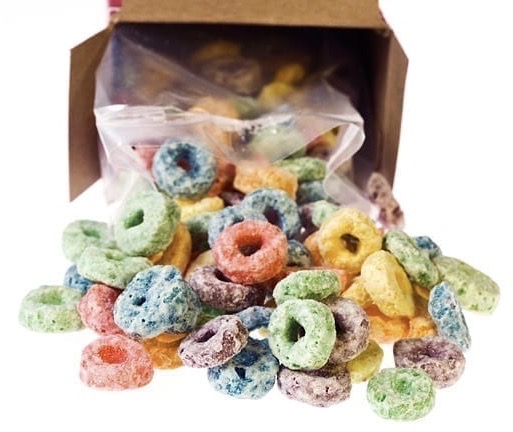Breakfast is an important part of starting off a productive day, providing nutrition, energy, and focus, but not all breakfasts are created equal, especially when it comes to kids’ cereals.
 Image courtesy of you beauty.The Environmental Working Group (EWG) just published a report that examined 84 popular cereals for sugar content, finding that most had more sugar than your average snack cakes and cookies.
Image courtesy of you beauty.The Environmental Working Group (EWG) just published a report that examined 84 popular cereals for sugar content, finding that most had more sugar than your average snack cakes and cookies.
The nonprofit research and consumer advocacy group found that children who eat high-sugar breakfasts have more problems at school.
“They become more frustrated and have a harder time working independently than kids who eat lower-sugar breakfasts. By lunchtime they have less energy, are hungrier, show attention deficits, and make more mistakes on their work,” said the EWG.
Topping the EWG’s list for most sugar in a kid’s cereal was Kellogg’s Honey Smacks at nearly 56 percent sugar content by box weight. “A one-cup serving of Honey Smacks packs more sugar than a Hostess Twinkie,” said the group.
EWG Top 10 Worst Kid’s Cereals for Sugar Content (sugar percentage by box weight)
- Kellogg’s Honey Smacks – 55.6 percent
- Post Golden Crisp – 51.9 percent
- Kellogg’s Froot Loops Marshmallow – 48.3 percent
- Quaker Oats Cap’n Crunch OOPS! All Berries – 46.9 percent
- Quaker Oats Cap’n Crunch Original – 44.4 percent
- Quaker Oats Oh’s – 44.4 percent
- Kellogg’s Smorz – 43.3 percent
- Kellogg’s Apple Jacks – 42.9 percent
- Quaker Oats Cap’n Crunch Berries – 42.3 percent
- Kellogg’s Froot Loops Original – 41.4 percent
The EWG finds that overall, only one in four kids’ cereals meets the voluntary guidelines proposed earlier this year by the federal Interagency Working Group on Food Marketed to Children – a panel of federal nutrition scientists and marketing experts assembled by Congress in an effort to fight childhood obesity in the United States.
For ready-to-eat cereals, the federal interagency guidelines recommend that there be no more than 26 percent added sugar by box weight.
The EWG would like to see even stronger federal guidelines proposed, saying that, “they should limit sugar content in cereal to no more than 15 percent, a bar already met by a number of children’s cereals, not the 26 percent cap currently proposed. They should be mandatory, not voluntary.”
The EWG added that scientific literature demonstrates the benefits of eating breakfast and whole grains, but does not support adding copious amount of sugar to children’s cereals.
“Most parents say no to desert for breakfast, but many children’s cereals have just as much sugar as a desert or more. Simple-to-prepare, healthy breakfasts for children can include fresh fruit and high-fiber, low-sugar cereals,” said the EWG.
EWG Top Picks For Good Big-Brand Kids’ Cereals (by brand and product)
- Kellogg’s Mini-Wheats:
- Unfrosted Bite-Size
- Frosted Big Bite
- Frosted Bite-Size
- Frosted Little Bites
- General Mills
- Cheerios Original
- Kix Original
For these good, big-brand cereals, the EWG says that they meet the government’s nutrition guidelines and are easy to find, but many include ingredients that are genetically modified or grown with pesticides.
EWG Picks For Best Overall Cereals (by brand and product)
- Ambrosial Granola:
- Athenian Harvest Muesli
- Go Raw:
- Live Granola
- Live Chocolate Granola
- Simple Granola
- Grandy Oats:
- Mainely Maple Granola
- Cashew Raisin Granola
- Swiss Style Muesli
- Kaia Foods:
- Buckwheat Granola Dates & Spices
- Buckwheat Granola Raisin Cinnamon
- Laughing Giraffe:
- Cranberry Orange Granola
- Lydia’s Organics:
- Apricot Sun
- Berry Good
- Grainless Apple
- Sprouted Cinnamon
- Vanilla Crunch
- Nature’s Path Organic:
- Optimum Banana Almond
- Optimum Cranberry Ginger
- Corn Puffs
- Kamut Puffs
- Millets Puffs
- Rice Puffs
These ‘best’ brand cereals all pass the proposed federal guidelines on sugar, sodium, fat, and whole-grain content. They are all free of artificial flavors, colors, and artificial sweeteners such as aspartame and sucralose.
On the whole, the EWG recommends cereals with a short ingredient list (added vitamins and minerals are okay), with high fiber and few or no added sugars.
These cereals are usually found on the top shelves of the cereal aisles. “They are harder to reach and not at eye level, but often less expensive,” adds the EWG.
Reader comments and input are always welcomed!